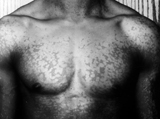 Tinea versicolor is a common fungal skin infection caused by the overgrowth of a type of fungus called Malassezia (formely called "pityrosporum").
Tinea versicolor is a common fungal skin infection caused by the overgrowth of a type of fungus called Malassezia (formely called "pityrosporum").
The overgrowth causes uneven skin color and scaling that may be mildly itchy and unsightly.
Tinea versicolor is not contagious.
The fungus is found on most people with normal skin, but some people under certain conditions are susceptible to an overgrowth of the fungus.
When the fungus grows in colonies, it produces a chemical that causes the skin to change color. The spots may appear pink or coppery brown in patients with fair skin. In darker skinned individuals, the spots may appear lighter than the surrounding skin.
The rash tends to appear on the upper back, shoulders, and chest, where the yeast thrives. It may also be seen on the limbs and face.
Tinea versicolor is more common in warm, humid climates and seems to be associated with excessive perspiration. People with tinea versicolor may notice that it comes back or worsens during hot summer months.
Tinea versicolor can be diagnosed with a special blue light called a Wood’s Lamp. The skin may also be scraped to obtain a specimen for examination under a microscope.
Treatment consists of antifungal medicines applied to the skin. These medications include clotrimazole, ketoconazole, and miconazole. Many over-the-counter dandruff shampoos contain antifungal ingredients and can be applied to the skin for 10 minutes each day in the shower to treat the lesions.
In cases of extensive or persistent tinea versicolor, oral antifungal agents, may be recommended.
Though tinea versicolor is easily treated, pigment changes may last for months after treatment. The condition may come back during the warm months.
Source: Vivacare
Last updated : 12/13/2021